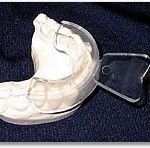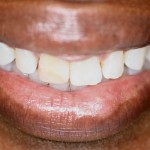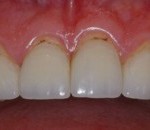It is normal to have unevenly colored teeth after bleaching, but that depends on the extent to which it occurs. With time, the color will appear more even. The problem may be related to what you do. It is important to avoid making some common post-bleaching mistakes, such as consuming foods and beverages that stain the surface of your teeth – soy sauce, coffee, wine, coke, etc.
It comes down to this – anything that will stain a white garment will stain your teeth as well. Since teeth are more porous during the bleaching process, they are more susceptible to stains. If coffee is something you cannot do without, you may have it in a way that will not stain your teeth, like drinking it through a straw. The length of time, over which you will have to be careful about what you eat and drink varies. You have to talk to your dentist about the specifics of this.
The cosmetic dentistry procedure sometimes produces an uneven effect – some areas of the teeth become whiter. A number of causes have been associated with this. For instance, you might not be applying the teeth whitening solution the right way. If you are buying tray-free generic materials from the drugstore, they lack the facility to stop the solution from pooling in one area and leave other parts of the tooth untouched. This is the reason for uneven color. To prevent it from occurring, you may opt for a custom fitting tray. Your dentist will be able to recommend a good one. You may be left with splotchy teeth, and this will be an unfortunate result of your teeth whitening efforts.
Other bleaching means that leave your teeth with a splotchy color are whitening strips, which touch some parts of the teeth and escape others. In Canada, dentists prepare custom trays which are suitable for the specific structure and form of your teeth. Custom trays have a particular size thickness of a reservoir to control the amount of solution that is applied both at the gum line of the tooth and at the area where the incision is made. The result is a more uniform and even color. You also have to keep in mind that fillings, bridges and other artificial structures will not whiten; so, do not expect them to. If you whiten your natural teeth, your restorative dentistry will stand out in stark contrast. It is possible to change the fillings to match the new tooth color following whitening.
Uneven coloring may also be the result of bleaching gel especially those who use the home whitening kits that contain a very low concentration of peroxide. This level works on some lighter stain but fails to penetrate the deeper and darker stains. This results in discoloration as the teeth enamel looks bright but is surrounded by darker and brownish marks. The shelf life of over-the-counter product may also result in uneven coloring as they lose their potency after a time span. To avoid such occurrence opting for the fresher kit would provide the best results. The person should purchase the kit which indicates the expiry date of 1 or 2 years. This ensures a relatively fresh kit.
Irregular tooth coloring also depends on the intensity of teeth stain and the causes of the stain. Coffee and cigarette stains are removable but medication spots such as tetracycline tends to be a tough job as it requires numerous treatment before the results are apparent.
Alternatively, the structure of the tooth itself can stop a uniform color from developing. Be aware that the edges of your teeth may lighten more quickly than their centers. This is because enamel tends to be thinner at a tooth’s edge. The center of the tooth has thicker enamel so it takes longer for the bleach to penetrate the area. Continue bleaching your teeth per your dentist’s instructions. You must give the less responsive teeth a chance to catch up to the whiter teeth. Oftentimes, teeth with less calcium respond to bleaching more quickly. Stop bleaching your teeth for a few days once they have reached their desired whiteness level. Initially, your teeth may appear uneven but after a few days, they should become more uniform. It generally takes between three to ten days for the color to even out across your teeth.
Another thing that can happen is that, as the gums recedes, the yellow part of the tooth becomes visible as the enamel thins out more and more. The root is yellow in colour as it is covered with cementum and dentin instead of enamel, and this can show under the white. In this case, it is recommendable to get your cosmetic dentist to put a veneer or a white filling to cover the yellow root. In this way, you will have a white and brilliant smile. Moreover, this is not as difficult as it seems!
Other than that, application of bleaching gel to decaying teeth is not a good option as this procedure only result in uneven teeth whitening. In super sensitive teeth cases it may give rise to pain. Cracks or chips in the tooth enamel also results in uneven teeth bleaching with some areas looking brighter than others.
Tips & Warnings
- You will have to re-bleach your teeth every six months or so, if you wish to maintain the lightened results.
- Stop bleaching your teeth and see your dentist if you experience extreme teeth sensitivity.



My sister’s teeth’s color is uneven. She tried DIY bleaching it and it’s still uneven. After reading this, we all advised her to visit the dentist. She’s now finally convinced to see a professional. Thanks for this!